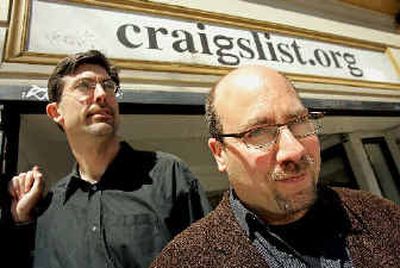Newspapers press on

SAN FRANCISCO — Craig Newmark already has tormented newspapers by creating a Web site where anyone can post ads at little or no cost, capturing an ever-growing share of the classified advertising market that had been one of the industry’s most dependable sources of revenue.
Now, the founder of Craigslist.org is pondering ways to improve upon newspapers. He smells an opportunity, convinced that publishers are more interested in preserving short-term profits than pursuing online audiences who still passionately care about journalism but don’t read newspapers.
“There is a lot of change coming and I want to make whatever contribution I can. I’m just not sure how yet,” Newmark said.
Newmark’s brainstorming may lead nowhere, but smarter newspaper publishers have learned to take the ideas of Internet entrepreneurs like him seriously as online search engines, help-wanted sites, the self-published journals known as “blogs” and other innovations chip away at readership and revenue.
A sense of urgency and concern has been running through the industry as news executives prepared for the annual meetings of the Newspaper Association of America and The Associated Press in San Francisco Sunday through Tuesday.
Attendees won’t have to stray far from their hotels to get a snapshot of the innovative technology companies threatening newspapers’ futures. A few miles away are the headquarters of not only Craigslist and assorted blogging services but also Google Inc. and Yahoo Inc., whose search engines make it increasingly easy for readers to stay informed without ever opening a newspaper.
“There are pockets of people within every (newspaper) who think we should be doing more on the Internet, but there are also other pockets of people who wish it would just all go away,” said Ian Murdock, senior vice president of the San Francisco Chronicle.
Ignoring the online threat doesn’t seem to be a viable business plan.
The Internet’s U.S. audience has steadily climbed during the past decade, reaching 164 million people who spent an average of 84 minutes per day online during March, according to comScore Media Metrix. And while they’re surfing the Net, they’re often reading stories most newspaper publishers offer for free.
Meanwhile, the total paid circulation of U.S. newspapers has been declining for nearly 20 years, dwindling from a peak of about 63 million to about 55 million, the association said.
The newspaper industry is finding it particularly difficult to attract the younger readers prized by advertisers. Just 39 percent of adults 18 to 34 years old read a newspaper last year, according to the association. More than two-thirds of adults 55 or older still read a paper.
“Newspaper readers are dying off faster than they can be replaced,” said industry analyst John Morton. “It’s a trend that’s been exacerbated by the Internet. It’s a fairly deep problem and it’s not going away.”
Most newspapers remain moneymaking machines, cranking out operating profits of roughly $20 for every $100 in sales, Morton estimated. But most also realize that traditional profit sources are drying up as advertisers follow readers online.
Many publishers have reacted by cutting newsroom budgets in order to continue generating the earnings growth demanded by their shareholders, but some industry experts consider such moves suicidal.
By cutting costs when they should be spending more money to become more competitive on the Internet, newspapers are heading toward a “profitable demise,” said Jay Rosen, a New York University journalism professor who recently published a pessimistic essay about the industry’s future.